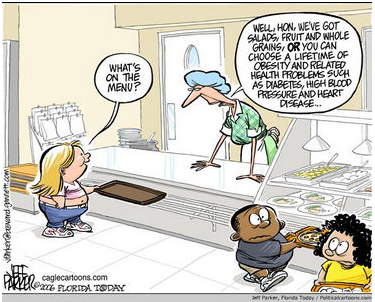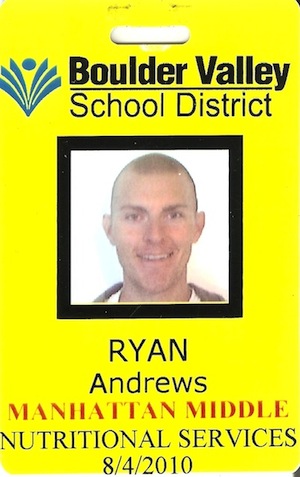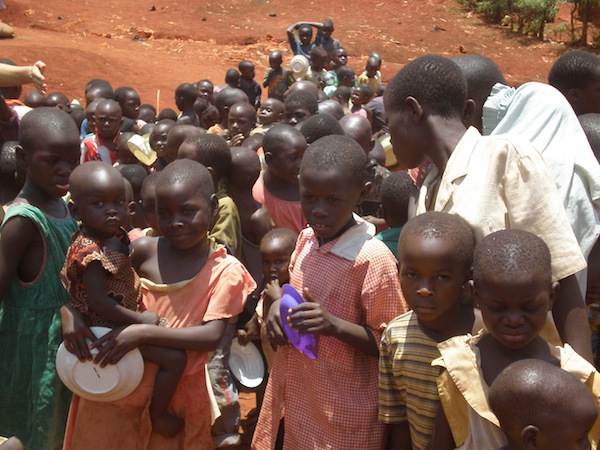It’s easy to be a school cafeteria know-it-all. That is, until you actually see what happens each day in a school cafeteria. Here are 18 lessons Coach Ryan Andrews learned during his one year stint as a school cafeteria worker.
If it’s Monday through Friday, 32 million children across the U.S. are eating a meal served at school.
I just spent the last 10 months contributing to this daily food party… as a lunch lady. (Here’s why I did it.)
And here’s what I learned.
 |
 |
| Me for the last 10 months | |
1. We can’t let kids dictate things
“Ryan, kids want cheesy pizza, burgers, and chocolate milk.” Great. When did we start letting kids make life decisions?
When I was a kid, if I dictated how my day went, I would have eaten Cinnamon Toast Crunch for all meals and played Donkey Kong instead of doing homework.
Think modern kids have evolved? They haven’t. Check out these videos I shot with students at the school:
Hot wings, Pizza Hut, fries, corn dogs, and Taco Bell?
“Too much broccoli”, more cheese and juice.
A la carte? They want hot Cheetos, Gatorade, and sushi.
This girl wants more vegetarian options…
(I promise I didn’t pay her off)
More soup, and veggie burgers would be cool.
Plus, more options and organic fresh salad bar ingredients.
2. Keep school food simple
To get serious about school food and its consequences, policy makers need to focus less on tinkering with funding formulas, surplus agricultural commodities, and % of calories from fat while focusing more on stopping kids from devouring plate after plate of hamburgers and cheesy noodles.
We’re trying to serve nutritious foods to kids. This food exists. Let’s make it happen.
3. Kids learn at school
There’s a strong disconnect with kids and food.
Example #1: I heard two students talking about factory farm video footage and how disturbed they felt after seeing a worker stomp on a calf’s head (see here). They both looked at each other with mouths agape. And then they both proceeded to get beef nachos with cheese.
I’m sure they figured the footage wasn’t real — like Transformers or Toy Story 2. Kids aren’t making the connection between what they see and what they eat.
Example #2: This year we served sweet potatoes. Lots of kids had never seen them. This is fine; it’s not a requirement to eat sweet potatoes for optimal health. But – I can assure you that the same kids who cannot identify a sweet potato can list all of the value meals at McDonald’s, candy bar brands, and soda flavours.
Why does learning take a hiatus at lunch? Let’s use this time to inform kids about food. You know, stuff like where it comes from, how it influences our bodies and the planet, and how to prepare it and treat it with respect.
Let’s have DVDs, posters, pamphlets, farmers, gardeners, chefs, dietitians, doctors, flat screen TVs with slide shows, and so forth. Side note: none of this would be funded by the food industry (e.g., dairy council, beef council, soy council, etc.).
If we don’t inform kids about food during lunch – where will they get this information? Parents? TV advertisements? Diet books?
Plans for summer include Pop Tarts and soda.
4. Kids won’t change until we (adults) change.
I’ve had countless discussions over the past year with adults about school lunch. Not one adult has been against nutritious and sustainable food options for kids.
But the same adults who want better school lunches for kids are crushing triple stack burgers during their lunch break and take medication for nutrition-related diseases. Apparently the adults don’t believe in nutritious/sustainable food enough to partake themselves.
School lunches won’t change until we (adults) make a genuine change.
There isn’t enough support to make healthful school lunches happen right now. If there were, it would be happening. Parents are unhealthy, school administrators are unhealthy, and now kids are unhealthy. Surprised?
I can assure you that if most parents, teachers, cafeteria workers (the front lines of school food), and school administrators believed in nutritious food (and physical education programs) and participated in it themselves, things would have changed by now.
5. It takes work to prepare nutritious foods (and compost)
Get ready U.S. cafeterias, it takes more time and effort to prepare nutritious whole foods, wash real utensils/plates, and handle food waste. Get used to it.
Reusable eatware
Composting
6. Nutritious school lunches cost more money
Cheap food is an illusion. The real cost is paid somewhere. If we don’t pay at the cafeteria cash register, then we pay with our kid’s health, the planet, the animals, and/or public funds.
Where will we get this money?
My genius ideas:
Nix dieting and supplements
American consumers spent $61 billion on diets and supplements last year. That’s $200 for every man, woman and child. So, instead of buying a low-carb diet book and/or the latest appetite suppressant, buy vegetables and beans for your local school.
Nix the new cell phone and/or car
The new ride looks pretty sweet, but it doesn’t help to prevent heart disease. Are you willing to forgo the upgraded cell phone plan or new car payment so your kid can have a few extra bucks for nutritious food? I am.
7. When kids are hungry, they’ll eat
Funny – when I was serving beans, rice and bananas to kids in Uganda (see photos below), I don’t remember any of them turning me down. Why? If kids are hungry – they will eat.
 |
 |
| Nope, no picky eaters here | |
8. Serve one entrée
The more choices, the more exhausted we get. Ever used a thesaurus? Good luck making a final word selection.
The paradox of choice: More choice, less satisfaction.
Let’s keep it simple and serve one entrée each day. This means less food prepared, less potential waste, less dishes to wash, and less money dedicated to the kitchen staff.
Kids don’t stand in the lunch line thinking about the long-term repercussions of their food choices (health, planet, animals, etc.). The smart option needs to be the only option. If it smells good, looks good, and tastes good – the kids are most likely going to eat it.
9. Let’s fundraise for school lunch
We’ve all experienced it: The middle schooler selling candles, candy or wrapping paper to raise money.
What about a fundraiser featuring baked goods the kids made (with decent ingredients)? Or a farmers’ market with produce grown at the school garden? All proceeds go to buying nutritious foods for lunches.
Another way to make extra money – let eco-friendly companies advertise on compost bins and recycling containers in schools.
10. Get some garden and farming action started
Our disconnect from food can decrease our respect for food. When a veggie burger doesn’t taste quite like a Big Mac, kids throw it out and complain. If we valued our food more, it would yield less unused food, reducing our excess.
What if school lunch prep and clean up was part of class time? If kids helped in the process, this could increase respect for the food (and food prep). Food wouldn’t just be an object that magically appears, and food servers wouldn’t just be robots who dish out pizza.
11. Handling money during lunch is a pain
Worrying about exchanging money each day distracts from what lunch is about – eating quality food. We want kids to have time to eat (instead of waiting to pay for lunch). And we want a staff dedicated to preparing and cleaning up from the meal, not counting quarters.
Students should pay one flat fee at the beginning of the school year (based on if they are low income, regular income, etc.). And that’s it. They can get lunch each day (or not).
12. Serve familiar (but slightly better) foods
I’m cool with serving a tempeh ginger stir-fry, but kids aren’t. We need to be careful with food descriptions.
If we have hamburgers and veggie burgers, the kids are going to buy hamburgers, even if they can’t taste a difference. Veggie burgers have a negative reputation.
If it tastes good, kids won’t know or care. It’s up to the lunch staff to make it more nutritious/sustainable.
Continue serving common foods, with a few tweaks:
- Burritos – made with beans and grilled vegetables
- Nachos – made with beans, salsa and avocado
- Pizza – made with whole grain crust and vegetables, non-dairy cheese
- Chili – with beans and veggies
- Lasagna – with whole grain pasta and veggies
- Burgers & hot dogs – plant-based
- Falafel and hummus
13. Lunch needs to follow recess
This simple change can decrease food waste by 30%. Kids won’t be rushing to get out and play, and they’ll be a lot more relaxed after some activity.
14. No lunch trays
When trays aren’t used, kids take less (they can always come back for more). This means less food waste and water used for washing trays.
15. Give away extra food
Each day, extra food that cannot be served again could be dropped at a food bank or homeless shelter.
Stores are allowed to deduct the fair market value of goods donated. Schools can do this too. Schools can donate extra food thanks to the Bill Emerson Good Samaritan Food Donation Act (excluding self-serve foods from salad bars).
16. Nix drug-like foods
You know how addicted you are to _______ (fill in the blank with your addictive food of choice)? This probably started in childhood.
Even the brightest students started to get a glaze in their eye when we served foods like pizza and hot dogs. When I distributed “seconds” of biscuits and carrot cake, I thought I was going to be ambushed.
17. Nix drinks
Yeah, I said it. This includes milk, juice, soda, etc. Kids can use the water fountain or bring a reusable water bottle. This will save cups (less waste) and likely improve health.
Liquid calories aren’t satiating. Kids can easily guzzle hundreds of excess (and often nutrition-free) calories every day.
Choosing unflavoured milk over flavoured milk is a step in the right direction. But in America, about 1/3 of cow’s milk isn’t consumed, giving it the second highest loss rate of any food. Who knows how much this loss rate goes up when you factor in school lunch programs?
Further, the environmental demands of dairy production can be substantial. Lactose intolerance will continue to be an issue, there are increasing concerns about hormones and drugs in milk, and dairy isn’t necessary for improving health.
Oh, and memo from the dish room – cheese isn’t worth it. High temps cook the cheese on pans. Nix dairy for the sake of the dishwashers.
18. Meat is a downer
Preparing, serving, and throwing away leftover meat gave me a negative karma punch each day. I didn’t think I would be overly distraught about serving meat – but I was. For each burger and chicken wing I served, it was another reminder that kids have minimal connection to where food comes from and how their choices impact others.
If you care about kids’ nutrition, get involved
Why did I get involved in the school lunch program?
Two words: Ann Cooper.
Ann cares about kids, nutrition and the planet. So do I. When Boulder recruited her to help with school lunches, I had to get involved. If you care about kids, nutrition and the planet, consider getting involved with a local school lunch program.
Volunteer. Work. Donate. Do what you can.
Eat, move, and live… better.©
The health and fitness world can sometimes be a confusing place. But it doesn’t have to be.
Let us help you make sense of it all with this free special report.
In it you’ll learn the best eating, exercise, and lifestyle strategies — unique and personal — for you.



Share